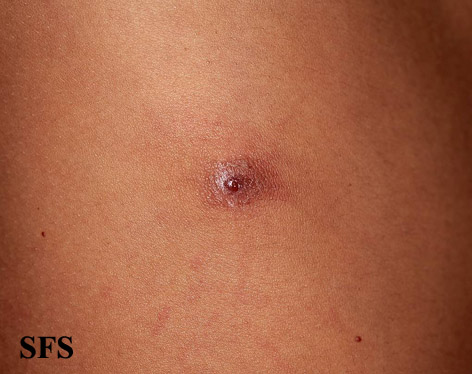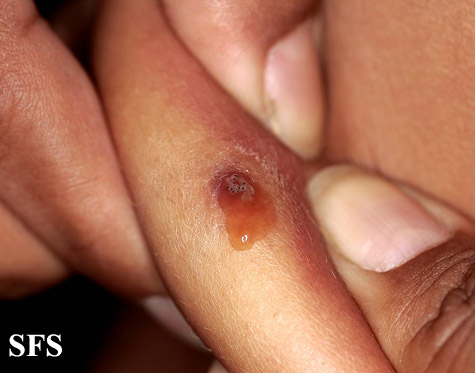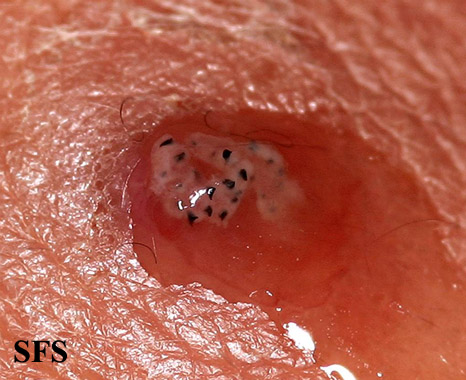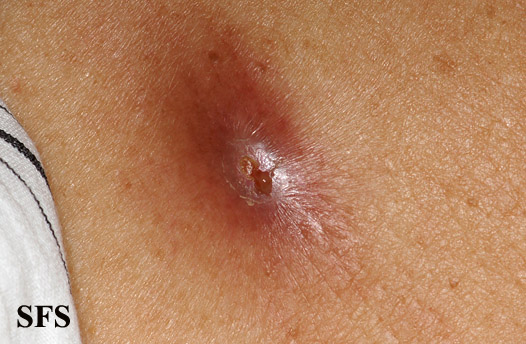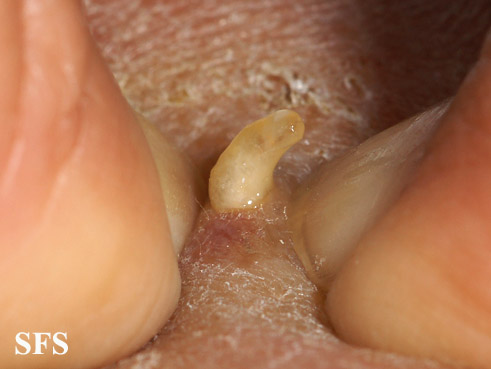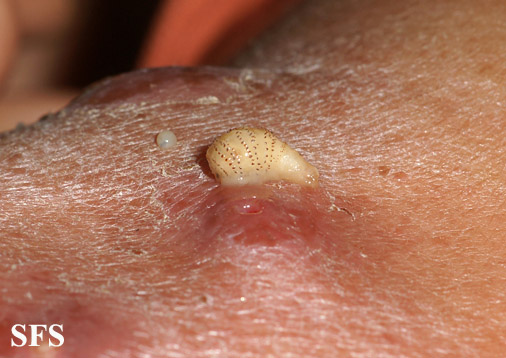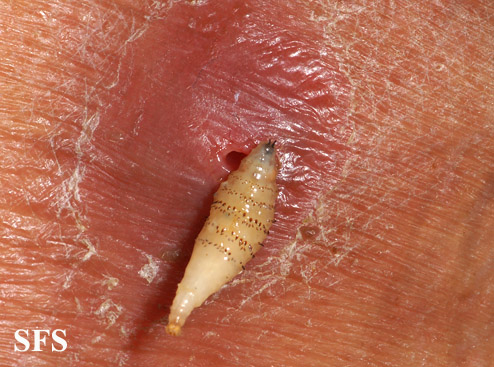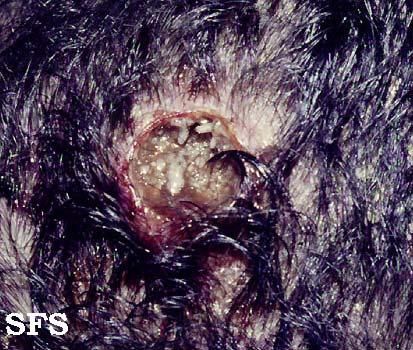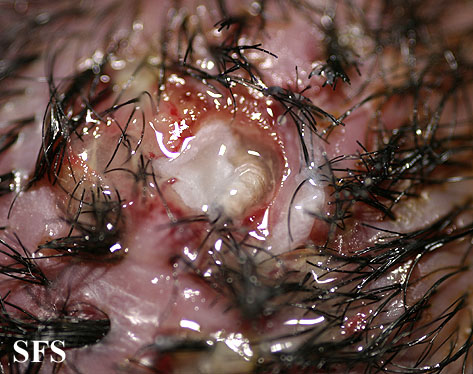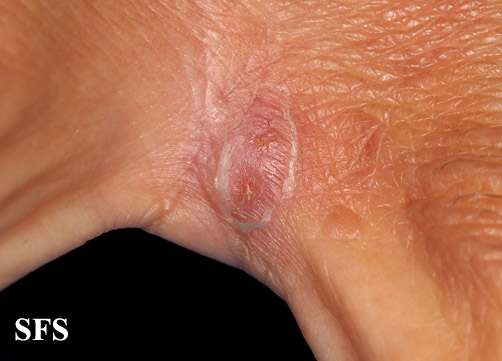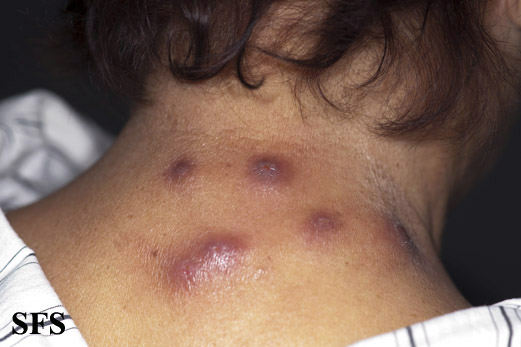Myiasis
|
WikiDoc Resources for Myiasis |
|
Articles |
|---|
|
Most recent articles on Myiasis |
|
Media |
|
Evidence Based Medicine |
|
Clinical Trials |
|
Ongoing Trials on Myiasis at Clinical Trials.gov Clinical Trials on Myiasis at Google
|
|
Guidelines / Policies / Govt |
|
US National Guidelines Clearinghouse on Myiasis
|
|
Books |
|
News |
|
Commentary |
|
Definitions |
|
Patient Resources / Community |
|
Directions to Hospitals Treating Myiasis Risk calculators and risk factors for Myiasis
|
|
Healthcare Provider Resources |
|
Causes & Risk Factors for Myiasis |
|
Continuing Medical Education (CME) |
|
International |
|
|
|
Business |
|
Experimental / Informatics |
Editor-In-Chief: C. Michael Gibson, M.S., M.D. [1]; Associate Editor(s)-in-Chief: Jesus Rosario Hernandez, M.D. [2].
Overview
Myiasis is an animal or human disease caused by parasitic dipterous fly larvae feeding on the host's necrotic or living tissue. Colloquialisms for Myiasis include "fly-strike" and "fly-blown".
Blowfly strike, known as myiasis, is a common disease in sheep, especially in areas where there are hot and wet conditions. The female flies lay their eggs on the sheep in damp, protected areas soiled with urine and faeces, mainly on the breech. It takes approximately 8 hours to a day for the eggs to hatch, depending on the conditions. This results in sores as the larvae lacerate the skin and this is the primary reason for the early removal of lambs' tails. The larvae then tunnel into the host's tissue causing irritating lesions. After about the second day bacterial infection occurs and if left untreated causes toxemia or septicemia. This leads to anorexia and weakness and if untreated will lead to death. Blowfly strike accounts for over $170 million a year in losses in the Australian sheep industry and so prevention measures such as mulesing are practiced.
German entomologist Fritz Zumpt describes myiasis as "the infestation of live human and vertebrate animals with dipterous larvae, which at least for a period, feed on the host's dead or living tissue, liquid body substances, or ingested food."
Classifications
Two different classifications of myiasis can be adopted:
- The classical classification describes the myiasis by the infected area of the host. This is the classification used by ICD-10. For example: dermal, sub-dermal, cutaneous (B87.0), nasopharyngeal (B87.3), ocular (B87.2), intestinal/enteric (B87.8), or urogenital (B87.8).
- Another classification is based on the relationship between the host and the parasite and provides insight into the biology of the fly species causing the myiasis and its likely effect. Thus the myiasis is described as either obligatory or facultative or accidental.
Flies responsible for Myiasis
There are three main fly families causing economically important myiasis in livestock and also, occasionally, in humans:
- Oestroidea (botflies)
- Calliphoridae (blowflies)
- Sarcophagidae (fleshflies)
Other families occasionally involved are:
The adult flies are not parasitic, but when they lay their eggs in open wounds and these hatch into their larval stage (also known as maggots or grubs), the larvae feed on live and/or necrotic tissue, causing myiasis to develop. They may also be ingested or enter through other body apertures.
Physical examination
Gallery
Skin
Head
Extremities
Neck
Control methods
The first control method is preventive and aims to eradicate the adult flies before they can cause any damage and is called vector control. The second control method is the treatment once the infestation is present, and concerns the infected animals (or humans).
Prevention
The principal control method of adult populations of myiasis inducing flies involves insecticide applications in the environment where the target livestock is kept. Organophosphorus or organochlorine compounds may be used, usually in a spraying formulation. One alternative prevention method is the SIT (Sterile Insect Technique) where a significant number of artificially reared sterilized (usually through irradiation) male flies are introduced. The male flies compete with wild bred males for females in order to copulate and thus cause females to lay batches of unfertilised eggs which can't develop into the larval stage.
Another prevention method involves removing the environment most favourable to the flies. One example of this is the crutching of sheep, which involves the removal of wool from around the tail and between the rear legs, which is a favourable environment for the larvae. Another more permanent practice which is used in some countries is mulesing, where skin is removed from young animals to tighten remaining skin - leaving it less prone to fly attack.[1] PETA have been campaigning to have farmers cease mulesing. Celebrities such as Pink, Toni Collette and Chrissie Hynde have also participated in PETA's campaign against the mulesing practice[2]; Collette has since changed her stance, however.[3]
Treatment
This applies once an infection is underway. First the larvae must be eliminated through pressure around the lesion and the use of forceps. Secondly the wound must be cleaned and disinfected. Further control is necessary to avoid further reinfection.
It is also possible to treat livestock with the use of slow release boluses containing ivermectin which can provide long term protection against the larvae development.
Sheep may be dipped, which involves drenching the sheep in insecticide to prevent the growth of the larvae.
Antimicrobial Regimen
- Myiasis
- Preferred regimen: No medications approved by the FDA are available for treatment[4]
- Note: Fly larvae need to be surgically removed.
Use of Myiasitic maggots in medicine
Through the ages maggots have been used in medicine in order to clean out necrotic wounds. For more information, see Maggot therapy.
Maggot Therapy (also known as Maggot Debridement Therapy (MDT), larval therapy, larva therapy, or larvae therapy), is the intentional introduction by a health care practitioner of live, disinfected green bottle fly maggots or larvae into the non-healing skin and soft tissue wound(s) of a human or other animal for the purpose of selectively cleaning out only the necrotic (dead) tissue within a wound in order to promote wound healing.
The larvae of the green bottle fly (a type of blow-fly) are now used exclusively for this purpose, since they preferentially devour only necrotic tissue, leaving healthy tissue intact. This is an important distinction, as most other major varieties of myiasitic fly larvae attack both live and dead wound tissue indiscriminately, effectively negating their benefit in non-harmful wound debridement.
References
- ↑ "Standard Operating Procedures - sheep Mulesing". New South Wales Department of Primary Industries. March 8,2004. Retrieved 2007-01-09. Unknown parameter
|works=ignored (help); Check date values in:|date=(help) - ↑ "Pink angers Australian government". BBC News. 20 December2006. Retrieved 2007-01-09. Check date values in:
|date=(help) - ↑ http://www.abc.net.au/rural/content/2005/s1416534.htm
- ↑ "Parasites - Myiasis".
